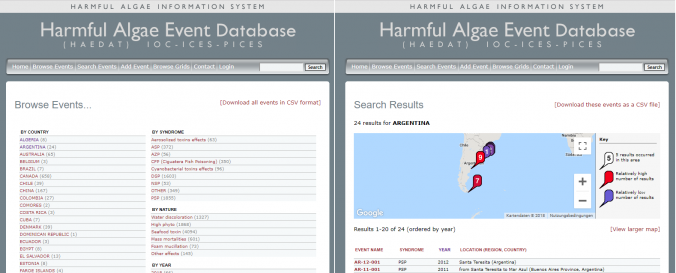Harmful Algae Event Database (HAEDAT - UNESCO/IOC)

| Data provided by: | Intergovernmental Oceanographic Commission (UNESCO/IOC) |
| Data accessibility: | Exportar datos, Datos estadísticos (ej. gráficos) |
| Link to the data: | |
| File type: | csv |
| Data type: | Datos sobre amenazas específicas |
| Hazard: | Harmful Algal Bloom |
| Disaster cycle phase: | Gestión des Riesgo por Desastres, Respuesta, Recuperación |
| Space-based Information: | The Harmful Algal Information System, HAIS, will when fully established consist of access to information on harmful algal events, harmful algae monitoring and management systems worldwide, current use of taxonomic names of harmful algae, and information on biogeography of harmful algal species. Supplementary components are an expert directory and a bibliography. The HAIS System is being built within the "International Oceanographic Data and Information Exchange" (IODE) of the "Intergovernmental Oceanographic Commission" (IOC) of UNESCO, and in cooperation with WoRMS, ICES, PICES, IAEA and ISSHA. HAEDAT Disclaimer: The HAEDAT database contains information based on yearly national reports by ICES and PICES member states. The available information on individual events varies greatly from event to event or country to country. Monitoring intensity, number of monitoring stations, number of samplings, stations, etc. also varies greatly and therefore there is not a direct proportionality between recorded events and actual occurrences of e.g. toxicity in a given region. |
| Spatial coverage: | Global |
| Spatial resolution: | <10m |
| Temporal coverage: | Archivado |
| Content dates: | 1985- Present |
| Costs: | Gratis |
| Contact: | Henrik Enevoldsen |
| Restrictions/ Citation of the dataset: | HAEDAT Disclaimer: The HAEDAT database contains information based on yearly national reports by ICES and PICES member states. The available information on individual events varies greatly from event to event or country to country. Monitoring intensity, number of monitoring stations, number of samplings, stations, etc. also varies greatly and therefore there is not a direct proportionality between recorded events and actual occurrences of e.g. toxicity in a given region. Furthermore, areas with numerous recorded occurrences of HAE's, but with an efficient monitoring and management programmes, may have very few problems and a low risk of intoxications, whereas rare HAE's in other areas may cause severe problems and represent significant health risks. |

